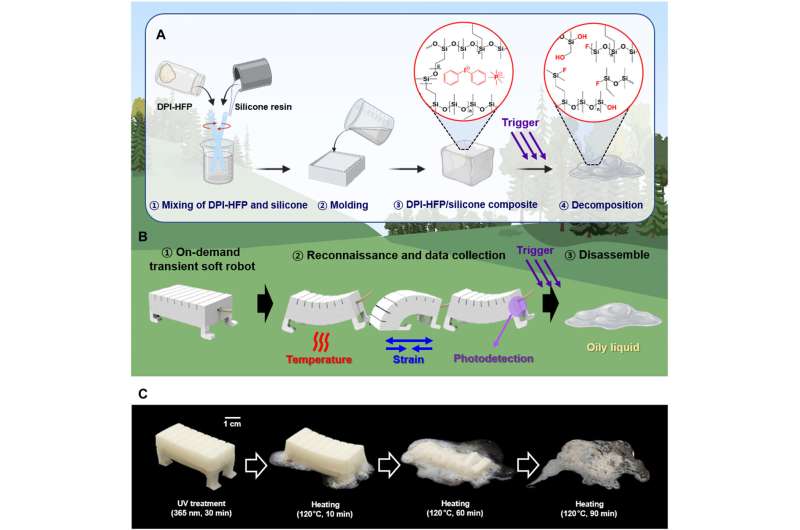August 29, 2023 report
This article has been reviewed according to Science X's editorial process and policies. Editors have highlighted the following attributes while ensuring the content's credibility:
fact-checked
peer-reviewed publication
trusted source
proofread
Soft robots self-destruct with little trace

Korean researchers say they have devised a robot that can self-destruct and leave no trace other than an oily puddle.
Working with soft robots—devices composed of flexible materials that can move, heal and grow like living organisms—the researchers spent two years developing materials strong enough to support a fully functional robot but capable of disintegrating when self-contained substances interact.
Such capability could ensure sensitive data on-board robots used in surveillance, scouting and transport missions would not be exposed to enemy or other unauthorized sources. Such robots could also be used on search missions in dangerous locations or environmentally hazardous areas where retrieval proves impossible or would be too expensive.
Researcher Min-Ha Oh, a graduate student at Seoul National University who worked on the project, said, "We have mimicked death in a life cycle where the robot could end itself."
Earlier soft robots containing thermoset silicone elastomer were not suitable for self-destruction. The material was resistant to heat, acids and chemicals and while desirable for its durability it was unacceptable for self-demolition.
Thermoplastic elastomers could melt, but the substance would reconstruct itself as polyurethane.
The Korean researchers instead applied a substance to silicone resin that releases fluoride ions when exposed to UV light. When operators trigger built-in UV LEDs to begin heating the substance, the robot begins to disintegrate. It would decompose in less than two hours, leaving only an oily liquid behind.
"We fabricated a highly deformable and fully degradable gaiting robot and demonstrated it in a hypothetical scouting scenario," said Oh. "Under certain scenarios wherein disintegration is desired, including mission completion, discovery by enemies, or disposal requiring volume reduction, the robot can be exposed to UV light and disintegrate into an unrecoverable form."
The concept of self-destructing mechanisms has led to interesting products over the years. Researchers at the University of Houston in Texas devised circuitry that self-destructs when exposed to water molecules. It not only would be applicable to war scenarios but to medicine as well.
Cornel University researchers teamed up with Honeywell Aerospace to develop chemical packets embedded in processors, that upon receiving a remote "kill signal," dissolve all the chips.
The Pentagon created a glider than could fly for nearly 100 miles and then vanish within four hours.
Even Amazon joined the race after filing a patent for a self-destructing delivery drone. In the event of a malfunction, the device would fly to a remote area and then break apart into small pieces, minimizing risk of harm or property damage.
Self-destruction has also proved to be popular in pop culture as well. In the 1960's, the original "Mission Impossible" TV series opened each episode with secret instructions provided to government agent Jim Phelps (played by Peter Graves, and a few decades later by Tom Cruise) recorded on a portable reel-to-reel tape player.
When the brief instructions ended, the tape and recorder burst into a cloud of smoke. (The comedy spy series "Get Smart" spoofed that opener with a tape recorder blowing up an entire locker room while remaining intact itself, while the secret message continued to loop.)
The Mike Myers character "Austin Powers" obliterated messages by pressing a "liquid hot magma" button. Will Smith deployed a device to wipe out incriminating evidence in "Enemy of the State."
And Captain Kirk uttered the classic command "Zero-zero-zero-destruct-zero" to deploy the auto-destruct procedure to keep the USS Enterprise from falling into enemy hands in "Start Trek II: The Wrath of Khan."
The paper, "Lifetime-configurable soft robots via photodegradable silicone elastomer composites," appears Aug. 25 in Science Advances.
More information: Min-Ha Oh et al, Lifetime-configurable soft robots via photodegradable silicone elastomer composites, Science Advances (2023). DOI: 10.1126/sciadv.adh9962
© 2023 Science X Network


















